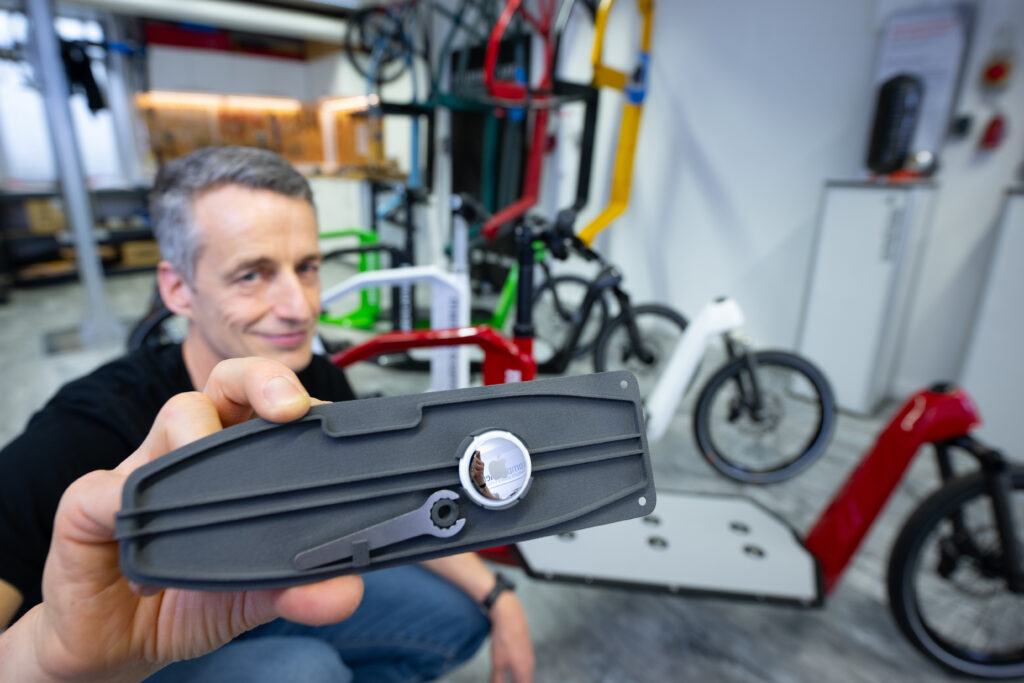The 3D printing industry is buzzing with interest in bike components, and the scene is exploding. Companies are manufacturing everything from bike seats to frames. Now, Evonik is stepping into the game with its materials being used in the increasingly popular cargo bike category, a favorite among hip urban families.
Previously, cargo bikes were cumbersome and heavy, making maneuvering or stopping difficult. However, a new wave of companies is employing techniques and materials such as styrofoam to make these vehicles lighter. Evonik reports that the market for cargo bikes grew by 40% last year and estimates a steady growth of 22% annually for the next few years.
Enter Maniac & Sane, a whimsically named startup founded by Martin Fleischhauer. Fleischhauer states:
“The latest cargo bikes incorporate a lot of technology. This requires new designs for certain functional parts: Passenger compartments are becoming more padded out, and 6-point safety belts are soon to be become a standard feature. With all these extras, cargo bikes are becoming real heavyweights on narrow inner-city bike paths,”
To combat this issue, Maniac & Sane is on a mission to innovate cargo bikes by 3D printing weight-saving components using Evonik’s INFINAM PA12 and powder bed fusion. As cargo bikes get more advanced, the company expects weight to become a key differentiator. Maniac & Sane partnered with Kegelmann Technik to create an AirTag mount and a lamp housing, designed to be lightweight and integrate with the bike’s frame. These initial steps are just the beginning, and the company is eager for more.

Sophie, we’ll call her, is happy because she and her husband, whom we’ll name Maximillian, can afford a house in Prenzlauer Berg and take two $13,000 bicycles to a skate park.
“We want to connect our designs with the emotions and passions of our customers so we can offer them a truly personal experience with our products. Among other things, this philosophy continues to result in new features such as illuminated logos, which we are currently adding to our design concept….and create new ways for designers to approach and implement things – and, ultimately, respond to customers’ individual wishes,” Martin says.
I love the idea of the company being able to create things like individual lamps or lamps that illuminate a unique or name based pattern. I also like that the firm could make unique and optimal holders for every customer. You never cycle without your morning latte, we´ll give you a latte holder, want some music on your bike here’s an integrated speaker. Your kid unable to focus on anything but a phone for ten minutes, we´ll add a holder. We have the right bag hooks for backpacks or a new divider for small groceries. To me this is a quick way to let people get lots of accessories on the bike. People could be persuaded by a new system that turns it from optimal kid transporter to shopping tool to heavy duty transport. I also really like the fact that this will let people quickly add lots of safety features to the bikes.
The potential to create custom accessories such as unique lamps, latte holders, integrated speakers, or specific bag hooks is exciting. This approach transforms a bike from a mere transportation tool to a multi-purpose vehicle, quickly adaptable with a variety of safety features.
There’s also potential for the company to quickly roll out niche versions using 3D printing. Collaborations with local businesses such as coffee shops or breweries can create an exclusive, localized appeal. Imagine a Third Wave Coffee version that becomes a local landmark outside a hip coffee place!
Mass-customized products like unique handles with vibration dampening can be more than lifestyle accessories; they can be aspirational symbols. Incorporating these personal touches enhances the buying experience, adds value, and makes a compelling business case. The Maniac model is priced at €9,995 and the Sane at €11,995 ($10,800 and $13,000 respectively). Now that, to me, is insane! Comparing it to other luxuries like a Rolex Submariner or a whole suite of other vehicles, you might wonder if the firm’s clientele are the maniacs. Are customers losing their minds? Or perhaps this high-margin niche is the right target for 3D printing, rather than the broader but less profitable automotive market.
Subscribe to Our Email Newsletter
Stay up-to-date on all the latest news from the 3D printing industry and receive information and offers from third party vendors.
You May Also Like
3D Printing Unpeeled: Orbex Investment, IndoMIM and HP, Ultrasonic Waves
INDO-MIM has bought three HP Metal Jet S100 printers, operating two in India and one in Texas. This is a win for HP because the company has deep experience in...
3D Printing News Briefs, April 3, 2024: Kickstarter FDM 3D Printer, Artificial Eyes, & More
In 3D Printing News Briefs today, we’re talking about an FDM 3D printer on Kickstarter, advancements in artificial eye creation, and 3D printed solenoids for electromagnets. Then we’ll move on...
Firestorm Gets $12.5M from Lockheed and Others to Automate Drone Production with 3D Printing
Firestorm Labs is advancing an initiative that has been a topic of discussion on our site for a while: automating drone swarm production. Drones are increasingly altering the landscape of...
3D Printing Leaders Team with Rivelin for Robotic Metals Post-processing
UK-based Rivelin Robotics is working on creating a manufacturing cell to automate the post-processing of metal 3D printed parts. If successful, this approach could reduce the costs of metal 3D...































